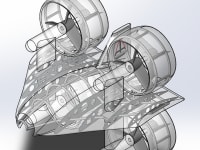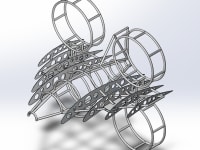By 2050 it is estimated that 68% of the world's population will live in cities. This will cause even more traffic in cities, a big problem especially in those cities that already have huge traffic problems with no infrastructure to fix these issues. New creative methods will be needed to solve the traffic dilemma. One solution that would not involve adding much infrastructure would be utilizing a third dimension. A vertical takeoff and landing (VTOL) tail sitter aircraft would make use of this third dimension and create an upward outlet for some of this traffic. Eventually, the commute in to work from the suburbs, will not only be more exciting, it will also be much faster.
Our VTOL aircraft will initially utilize four gas turbine turboprop engines, however, our future for this vehicle include fully electric engines. The advantage of a tail sitting VTOL craft over other VTOL crafts, is that the same engines used for forward flight are also used for the vertical takeoff and landing. This type of VTOL craft has not yet been explored within the personal vehicle realm, which is why this such an exciting endeavor. The wing shape will be a cropped delta wing. With the four propellers in a quadcopter arrangement, the aircraft will take off vertically. Once it has reached a safe altitude it will move and slowly tilt forward until the craft is in level horizontal flight. In this mode it will act as a normal airplane we think of today. The pilot will begin in a standing up position and will end in a prone position once the craft has fully transitioned. This will give the sensation of real flight, exciting flight with an interior cabin designed ergonomically for a comfortable flight. The craft will have a top speed of over 90 miles per hour once in horizontal flight, showing once again how exciting and useful this craft will be.
This flying experience will be like none other, and is designed with the public in mind. A pilot’s license will not be required as there will be robust autopilot control that is equipped with point to point navigation, as well as manual controls with automated fail safes for when the pilot wants to fly. This craft is tiny in comparison to normal planes. With maximum dimensions of 6.5’X6.5’X6,’ the craft will fit easily into convenient parking spaces, and will not require high material costs as it is very compact.
The craft itself will be relatively easy to manufacture, with a craft structure composed of aluminum and carbon composite aspects. Stock JetCat turboprop engines will be used as the powerplant for this craft, and nearly all components of our design are readily available to the aerospace market. The novelty of this design comes from its application and new autopilot technologies. Overall, it makes a lot of sense to be designing an exciting VTOL craft that will help solve problems of the future.
Like this entry?
-
About the Entrant
- Name:Heath Palmer
- Type of entry:teamTeam members:Jacob Gamertsfelder, Lynn Pickering, Heath Palmer, Dr. Shaaban Abdallah, and Hyperloop UC - Fly UC
- Software used for this entry:ANSYS, Hypermesh, Solidworks
- Patent status:none








